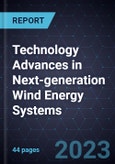Innovative Design Approaches and Enhanced Cost-efficiency, Reliability, and Sustainability are Driving Transformational Growth
Wind energy is expected to play a vital role in achieving emission reduction targets across industries. However, conventional wind energy systems face several challenges, including limited land availability, intermittent power generation, and the inability to exploit low- and high-speed wind environments. This report studies the next-generation wind systems’ potential to address the challenges faced by conventional wind turbines. It comprises a deep-dive analysis of next-generation wind energy technology, covering the fundamentals, working principles, technology capability, applications, and commercial readiness levels of emerging systems, including floating wind energy systems, bladeless wind turbines, airborne wind energy systems (AWESs), vertical-axis wind turbines (VAWTs), and direct-drive wind turbines.
The report includes case studies showcasing innovative design approaches to wind generation and examines the patent landscape of next-generation wind energy technology. It also highlights the key stakeholders developing innovative wind energy solutions in the energy sector. The study identifies the factors driving and restraining the next-generation wind energy system market and concludes by providing a detailed analysis of the growth opportunities emerging from the changes in this space for developers and operators to leverage.








